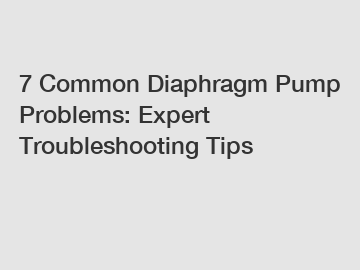7 Common Diaphragm Pump Problems: Expert Troubleshooting Tips
When it comes to diaphragm pumps, as with any mechanical equipment, issues can occasionally arise. From minor hiccups to more significant problems, understanding the common challenges and knowing how to troubleshoot them can save you time, money, and frustration. In this blog post, we will explore seven common diaphragm pump problems and provide expert troubleshooting tips to help you resolve them effectively.
1. Diaphragm Wear and Tear:
Problem: Over time, the diaphragm in a pump can experience wear and tear, leading to reduced performance and potential leaks.

Troubleshooting Tip: Regularly inspect the diaphragm for signs of damage, such as cracks or holes. Replace it if necessary, ensuring you choose a compatible diaphragm material that suits the fluid being pumped.
2. Leakage Issues:
Problem: Leaks in diaphragm pumps can occur due to a variety of reasons, including loose fittings, worn seals, or damaged diaphragms.
Troubleshooting Tip: Inspect all connections for loose fittings and tighten them as needed. Check the seals and gaskets for any signs of wear or damage, replacing them if necessary. Additionally, ensure the diaphragm is installed correctly and that it remains in good condition.
3. Insufficient Pumping Capacity:
Problem: If your diaphragm pump is not delivering the required flow rate or pressure, it may indicate an insufficiency in pumping capacity.
Troubleshooting Tip: Verify that the pump's intake and discharge lines are properly sized and free from obstructions. If the issue persists, check for worn or damaged valves, as they may affect the pump's ability to generate the desired pressure. Replace any faulty valves to restore optimal pumping capacity.
4. Air Locks and Cavitation:
Problem: Airlocks occur when air becomes trapped within the pump, disrupting its functioning. Cavitation, on the other hand, is caused by low-pressure conditions, leading to the formation of small vapor-filled cavities that can damage the pump.
Troubleshooting Tip: To eliminate airlocks, ensure all air release valves are functioning correctly and that the pump is properly primed. Cavitation can be mitigated by adjusting the pump's speed, boosting the fluid's temperature, or implementing a system that maintains a constant positive pressure at the suction side.
5. Reduced Pump Efficiency:
Problem: A drop in the pump's efficiency, resulting in decreased flow and increased energy consumption, may be caused by issues such as worn valves or an inadequate sealing system.
Troubleshooting Tip: Inspect the valves for wear or damage and replace them if required. Additionally, ensure the sealing system is properly lubricated and functioning optimally. Regular maintenance, including cleaning and lubrication, can significantly improve pump efficiency.
6. Vibrations and Noises:
Problem: Unusual vibrations and noises coming from the pump may suggest misalignment, loose parts, or internal damage.
Troubleshooting Tip: Check for any loose mounting bolts or misaligned parts and rectify them accordingly. If the vibrations persist, it may indicate internal damage, prompting professional examination and, if necessary, repair.
7. Chemical Compatibility Issues:
Problem: Different fluids require specific diaphragm materials. Failure to choose the appropriate material can lead to chemical compatibility issues, resulting in damage to the diaphragm or reduced pump performance.
Troubleshooting Tip: Research and select a diaphragm material that is compatible with the fluid being pumped. Consult with the manufacturer or supplier to ensure the proper material choice, taking into account factors such as chemical composition, temperature, and pressure requirements.
Conclusion:
Understanding the common problems that can arise with diaphragm pumps and knowing how to troubleshoot them is crucial for maintaining efficient and reliable pumping operations. By being proactive with regular inspections, preventive maintenance, and prompt repairs, you can extend the lifespan of your diaphragm pump while ensuring optimal performance. Remember, when in doubt, always consult with manufacturers or industry professionals for expert guidance tailored to your specific circumstances. Happy pumping!
Contact us to discuss your requirements of sanitary diaphragm pump supplier, diaphragm pump sizes, diaphragm pump not working. Our experienced sales team can help you identify the options that best suit your needs.
103
0
0


Comments
All Comments (0)